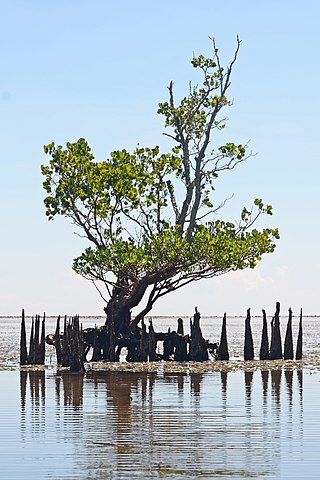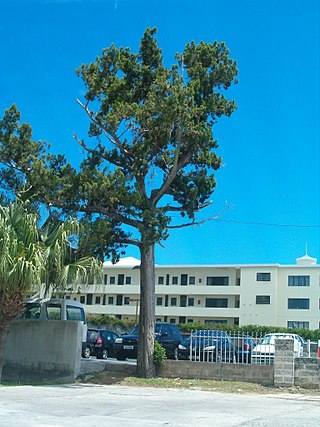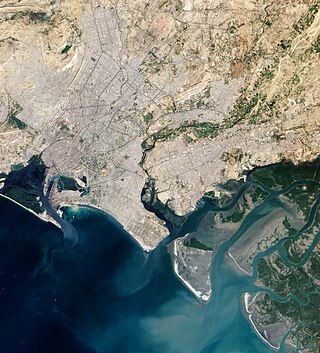
A mangrove is a shrub or tree that grows mainly in coastal saline or brackish water. Mangroves grow in an equatorial climate, typically along coastlines and tidal rivers. They have special adaptations to take in extra oxygen and to remove salt, which allow them to tolerate conditions that would kill most plants. The term is also used for tropical coastal vegetation consisting of such species. Mangroves are taxonomically diverse, as a result of convergent evolution in several plant families. They occur worldwide in the tropics and subtropics and even some temperate coastal areas, mainly between latitudes 30° N and 30° S, with the greatest mangrove area within 5° of the equator. Mangrove plant families first appeared during the Late Cretaceous to Paleocene epochs, and became widely distributed in part due to the movement of tectonic plates. The oldest known fossils of mangrove palm date to 75 million years ago.

The flora and fauna of Bermuda form part of a unique ecosystem due to Bermuda's isolation from the mainland of North America. The wide range of endemic species and the islands form a distinct ecoregion, the Bermuda subtropical conifer forests.

Avicennia marina, commonly known as grey mangrove or white mangrove, is a species of mangrove tree classified in the plant family Acanthaceae. As with other mangroves, it occurs in the intertidal zones of estuarine areas.

Rhizophora mangle, also known as the red mangrove, is a salt-tolerant, small-to-medium sized evergreen tree restricted to coastal, estuarine ecosystems along the southern portions of North America, the Caribbean as well as Central America and tropical West Africa. Its viviparous "seeds", in actuality called propagules, become fully mature plants before dropping off the parent tree. These are dispersed by water until eventually embedding in the shallows.

Avicennia germinans, the black mangrove, is a shrub or small tree growing up to 12 meters in the acanthus family, Acanthaceae. It grows in tropical and subtropical regions of the Americas, on both the Atlantic and Pacific Coasts, and on the Atlantic Coast of tropical Africa, where it thrives on the sandy and muddy shores where seawater reaches. It is common throughout coastal areas of Texas and Florida, and ranges as far north as southern Louisiana and northern Florida in the United States.
The Florida mangroves ecoregion, of the mangrove forest biome, comprise an ecosystem along the coasts of the Florida peninsula, and the Florida Keys. Four major species of mangrove populate the region: red mangrove, black mangrove, white mangrove, and the buttonwood. The mangroves live in the coastal zones in the more tropical southern parts of Florida; mangroves are particularly vulnerable to frosts. Mangroves are important habitat as both fish nursery and brackish water habitats for birds and other coastal species.

The Maranhão mangroves is a mangrove ecoregion of northern Brazil. It supports half of the shorebird population of the country. The combination of flat land, heavy rainfall and high tides causes the mangroves to extend up to 40 kilometres (25 mi) inland, where they are interspersed with other rainforest species.

The tall-stilt mangrove belongs to the Plantae kingdom under the Rhizophoraceae family. R. apiculata is distributed throughout Southeast Asia and the western Pacific islands.

The New Guinea mangroves is a mangrove ecoregion that covers extensive areas of the coastline New Guinea, the large island in the western Pacific Ocean north of Australia.

Avicennia alba is a species of tropical mangrove in the family Acanthaceae. It is found growing in coastal and estuarine locations in India, Southeast Asia, Australia, and Oceania.

The Indus River Delta-Arabian Sea mangroves are a large mangrove ecoregion on the Arabian Sea coast of Sindh Province, Pakistan, and the Gulfs of Kutch and Khambhat in Gujarat, India. The mangroves are the seventh largest mangrove forest in the world.

Salt ponds are a natural feature of both temperate and tropical coastlines. These ponds form a vital buffer zone between terrestrial and marine ecosystems. Contaminants such as sediment, nitrates and phosphates are filtered out by salt ponds before they can reach the ocean. The depth, salinity and overall chemistry of these dynamic salt ponds fluctuate depending on temperature, rainfall, and anthropogenic influences such as nutrient runoff. The flora and fauna of tropical salt ponds differ markedly from those of temperate ponds. Mangrove trees are the dominant vegetation of tropical salt pond ecosystems, which also serve as vital feeding and breeding grounds for shore birds.

Laguna de la Restinga is a national park on the Isla Margarita, Nueva Esparta state, Venezuela. The main part of the park is a large salt lagoon, rich in fish and birdlife. It is on the Ramsar list of wetlands of international importance, and is classified as an Important Bird Area.

Rhizophora racemosa is a species of mangrove tree in the family Rhizophoraceae. It has a patchy distribution on the Pacific coast of Central and South America, occurs in places on the Atlantic coast of that continent, and has a more widespread range on the Atlantic coast of West Africa.

The Guianan mangroves (NT1411) is a coastal ecoregion of southeastern Venezuela, Guyana, Suriname, French Guiana and Brazil. The mangroves provide an important habitat for migrating birds that winter in the area. Large areas are intact, although they are threatened by destruction of the trees for timber and to make way for agriculture, and from upstream agricultural and industrial pollution.

The Pará mangroves (NT1427) is an ecoregion along the Atlantic coast of the state of Pará in Brazil. They constitute the western extension of the Maranhão mangroves ecoregion. The mangroves are relatively intact, although they are under some pressure from agriculture and logging.

The Lesser Antilles mangroves ecoregion covers the salt-water habitats along the coasts of the islands on the divide between the Caribbean Sea and the Atlantic Ocean. the included islands stretch from Anguilla in the north to the island of Grenada in the south. The species diversity of these small islands is less than that of the larger islands of the Greater Antilles with to the west, but endemism is high due to the relative isolation of the different islands.

The Trinidad mangroves ecoregion covers the separate mangrove forest areas on the coast of the island of Trinidad, in the country of Trinidad and Tobago. The character of the mangroves is affected by the large amount of fresh water flowing out of the Orinoco River and Amazon River to the south, which flow northwest around the island. The mangroves of Trinidad are found on all coasts, and are usually in the estuaries of rivers, but also found in coastal lagoons.

The Alvarado mangroves ecoregion covers a series of mangrove forest areas along the Gulf of Mexico coast of the states of Tamaulipas and Veracruz in Mexico. they are the most northerly mangroves in the western Gulf. The largest tracts of mangrove swamps occur at the mouths of rivers, and nearby coastal lagoon.


















